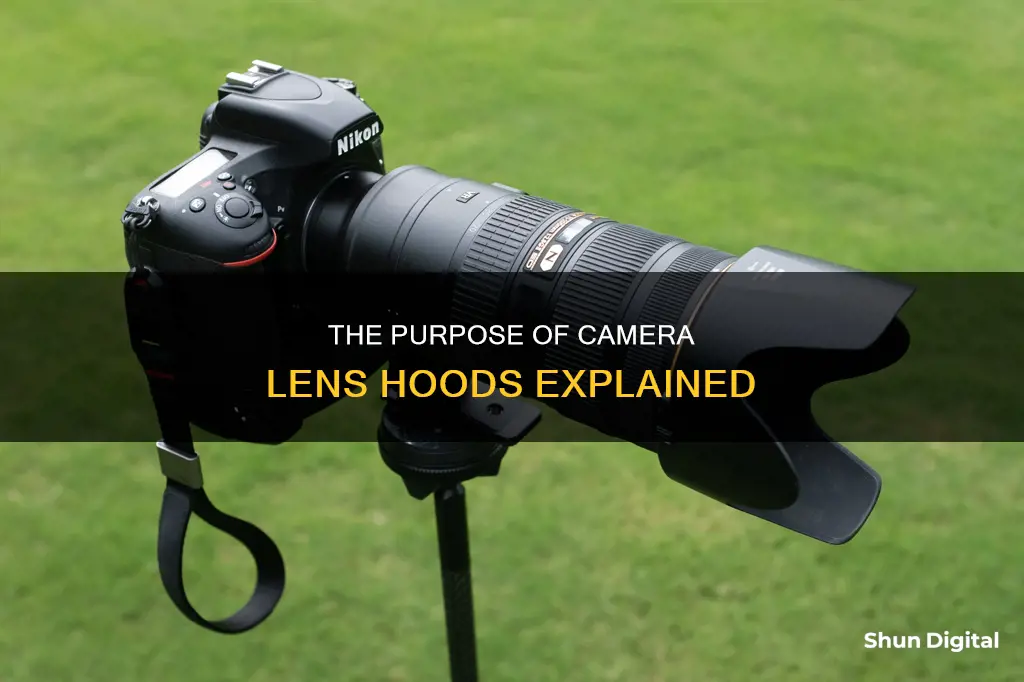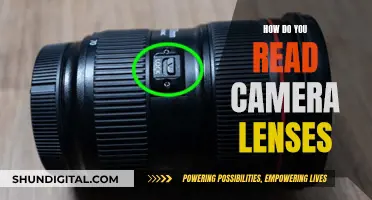
A camera lens hood, also known as a lens shade, is an accessory that attaches to the front of your camera lens. It blocks stray light from causing flare in your photographs and also protects the lens from damage. The main purpose of a lens hood is to reduce the amount of lens flare that appears in an image, which can look like streaks of light or hazy patches. Lens hoods also improve the overall contrast and colours in a photo, and they offer some degree of physical protection for the lens.
| Characteristics | Values |
|---|---|
| Purpose | To block unwanted light, prevent glare and lens flare |
| To protect the lens from damage, scratches, fingerprints, rain and snow | |
| To improve image quality, colour saturation and contrast | |
| Types | Cylindrical |
| Petal/Tulip | |
| Round | |
| Use Cases | When shooting into the sun or near strong sunlight |
| When using off-camera flash or a bright, off-camera light source | |
| Night photography | |
| When shooting backlit subjects | |
| When shooting in harsh weather conditions | |
| When storing and transporting the lens |
What You'll Learn

Blocking unwanted light
A lens hood is a device that attaches to the front of a camera lens to block unwanted light from entering the lens from an angle. This unwanted light, or "stray light", can cause lens flares, ghosting, reduced contrast, and lower the overall quality of an image.
Lens hoods are particularly useful when shooting into or near strong sunlight, or when your subject is backlit. They are also useful for indoor flash photography and studio photography, where off-camera flash or bright light sources can cause lens flare.
The geometry of a lens hood is dependent on the focal length of the lens, the size of the front lens element, and the dimensions of the image sensor or film in the camera. The shape of a lens hood can vary from a plain cylindrical or conical section to a more complex "petal", "tulip", or "flower" shape. The latter designs are intended to block every last bit of ambient light, with their notches allowing as much room as possible for the four corners of an image.
Lens hoods also offer some degree of physical protection for the lens, as they extend further than the lens itself, providing a barrier against accidental impact, scratches, fingerprints, rain, and snow.
Understanding Camera Lenses: Capturing Unique Perspectives
You may want to see also

Protecting the lens from damage
A lens hood is a vital accessory for protecting your camera lens from damage. It acts as a barrier, safeguarding the lens from accidental bumps and knocks. The hood will take the brunt of any collision, sacrificing itself to save your lens—a much cheaper replacement. It's a preventative measure that can save you from costly repairs or replacements.
Lens hoods also protect the lens from scratches, fingerprints, and the elements. They act as a shield, keeping the lens surface free from unwanted marks and smudges. This is especially useful if you're shooting outdoors in rainy or snowy conditions, as the hood will repel moisture and keep your lens dry.
The hood's extension beyond the lens itself provides this physical protection. Its design ensures that any impact will be on the hood rather than the lens. This is particularly useful when your camera is hanging from your shoulder or when you're on the move, reducing the chances of accidental damage.
Additionally, lens hoods can protect your lens from debris and dirt, ensuring that your equipment stays clean and functional. This is especially beneficial in harsh weather conditions, providing an extra layer of defence for your valuable camera gear.
Lens hoods are not just about protection; they also enhance image quality by reducing lens flare and improving contrast and colour saturation. However, their role in safeguarding your lens from damage cannot be overstated, giving you peace of mind and prolonging the life of your equipment.
Lens and Camera Compatibility: Universal Fit or Not?
You may want to see also

Improving image quality
A camera lens hood is a device attached to the front of a camera lens to block unwanted light from entering the lens and improve image quality.
Reducing Lens Flare
Lens flare occurs when stray light from a bright light source, such as the sun, reflects off the glass elements within the lens, creating circles of light or hazy patches in your photos. A lens hood blocks this unwanted light, reducing lens flare and improving image quality.
Improving Contrast and Colour Saturation
By reducing lens flare, a lens hood helps to maintain the contrast and saturation of your images, resulting in more vibrant and punchy colours. This is especially noticeable when shooting in high-contrast scenes or towards a bright light source, such as the sun.
Protecting Your Lens
In addition to improving image quality, a lens hood also offers some physical protection for your lens. It extends beyond the lens itself, providing a barrier against accidental bumps, scratches, fingerprints, and the elements, such as rain or snow.
When to Use a Lens Hood
It is recommended to use a lens hood whenever possible to improve image quality and protect your lens. However, there are a few situations where you may not want to use one. If you are intentionally creating lens flare for creative effect, using a pop-up flash, or using a wide-angle lens, you may want to remove the lens hood to avoid vignetting (darkening of the corners) or blocking the flash.
Types of Lens Hoods
Lens hoods come in various shapes, including cylindrical, conical, petal, tulip, or flower designs. The shape depends on the focal length of the lens, the size of the front lens element, and the dimensions of the image sensor or film in the camera. Cylindrical and conical lens hoods are typically used with prime or telephoto lenses, while petal or tulip lens hoods are often used with standard zoom lenses to avoid appearing in the image.
Cleaning Camera Lenses: DIY Home Solutions
You may want to see also

Reducing lens flare
A camera lens hood is an essential accessory for photographers aiming to enhance their images by reducing lens flare and improving overall picture quality.
Lens flare occurs when stray light enters the lens and bounces around within it, creating unwanted glare and reducing image contrast. This typically happens when shooting in the direction of a strong light source, such as the sun, bright studio lights, or a bright white background.
By attaching a lens hood to the front of your camera lens, you can effectively block this stray light from entering the lens, thereby reducing lens flare and its detrimental effects on your images. The hood acts as a visor, casting a shadow over the lens and preventing the sun or other bright light sources from directly hitting the lens surface.
The effectiveness of a lens hood in reducing flare is influenced by its geometry, which depends on the focal length of the lens, the size of the front lens element, and the dimensions of the image sensor or film in the camera. Additionally, the shape of the lens hood can vary, with cylindrical, conical, or petal-shaped hoods being the most common. The shape selected will depend on the lens type and the desired level of light blocking and vignetting control.
In summary, by using a camera lens hood to block unwanted light, photographers can significantly reduce lens flare, improving image contrast and overall quality.
Why Are Camera Lenses So Affordable?
You may want to see also

Adding contrast
A camera lens hood is an accessory that attaches to the front of your camera lens. It acts as a visor, blocking unwanted light from entering the lens and causing lens flares, which can reduce the contrast and lower the overall quality of your image.
Lens hoods improve the overall contrast and colours in a photo. They prevent large spots of lens flare and discolouration, ensuring shadows remain dark and aren't washed out. This is achieved by reducing stray light, which can enter the lens from bright light sources such as the sun, bright studio lights, or a bright white background.
Lens hoods are particularly useful when shooting towards the sun, or in high-contrast scenes, as they dramatically reduce the risk of lens flares. They are also beneficial for night photography, as they can block harsh light from sources such as street lamps, car lights, and building lights, which might otherwise cause lens flare.
The geometry of a lens hood depends on the focal length of the lens, the size of the front lens element, and the dimensions of the image sensor or film in the camera. The shape of a lens hood can vary from cylindrical or conical to more complex petal, tulip, or flower shapes. The shape is designed to block light while maximising the light entering the corners of the image, reducing vignetting (the darkening of corners in an image).
Lens hoods also offer some physical protection for the lens, providing a barrier against accidental bumps, scratches, fingerprints, rain, and snow.
Attaching Camera Lens Covers: A Step-by-Step Guide
You may want to see also
Frequently asked questions
A camera lens hood, also known as a lens shade, is used to block unwanted light from entering the lens and causing flare in your photographs.
A camera lens hood blocks light from going over the front element of the lens, preventing lens flare and improving image quality.
Aside from minimising flare, lens hoods improve the overall contrast and colours in a photo. They also offer some protection for the lens, reducing the risk of accidental damage, scratches and fingerprints.
You should use a camera lens hood whenever possible, especially when shooting in strong sunlight or when your subject is backlit.







